Standards in social statistics: The capacity of national statistical systems to adapt to the international standards, problems, challenges
Abstract
National statistical systems have been faced with the demand for more timely and granular social statistics. Addressing the demand is a challenge but new data sources have become available. In this context, a strong foundation in the generation of statistics is needed for national statistical systems given the availability of data sources outside of the traditional ones. Many statistical systems have gained trust by using international statistical standards and they should continue to benefit from newer standards that result from the Sustainable Development Goals requirements and the availability of newer sources of data. However, challenges persist. Focusing on those related to standards, the following are the challenges: lack of resources and technical knowledge on international standards; lack of inventory of international standards for entities within the national statistical system; lack of knowledge by line ministries on professional and technical independence and code of ethics; inadequate human and financial resources; insufficient awareness among line ministries on the importance of implementing international standards. To address the deficiency of data, especially on social sector statistics, traditional methods and tested frameworks should be augmented by new sources of information. The implementation of the Cape Town Global Action Plan for Sustainable Development (CT-GAP) is crucial in addressing the challenges. The national statistical systems of Mexico, led by the Instituto Nacional de Estadistica y Geografia (INEGI), and the Philippines, led by the Philippine Statistics Authority (PSA), are examples of how developing countries address challenges to producing official statistics.
1.Introduction
National statistical systems have been faced with the demand for more timely and granular social statistics. This demand was amplified by the 2030 Agenda for Sustainable Development [1] adopted by the UN General Assembly in September 2015. It required the indicators for use to monitor the accomplishment of the agenda to be disaggregated by income, sex, age, race, ethnicity, migratory status, disability and geographic location, where relevant. Addressing the demand has been a challenge for countries. In this context, a strong foundation in the generation of statistics is needed for national statistical systems given the availability of data sources outside of the traditional ones. This strong foundation includes statistical standards, especially for social statistics such as poverty, gender equality, maternal mortality, informal sector, and migration.
Many statistical systems have gained trust by using international statistical standards and they should continue to benefit from newer standards that result from the Sustainable Development Goals requirements and the availability of newer sources of data. Challenges faced by statistical systems are the same ones faced in the past. However, some new solutions have been made available for them. Some of them are the use of new technology, new frameworks, new sources of data, new partnerships. This paper aims to discuss the challenges and solutions that national statistical systems face as they adapt international standards in generating official statistics.
2.National statistical systems and their performance
National statistical systems produce official statistics from various sources guided by the United Nations Fundamental Principles of Official Statistics. The theory of change for strengthening them starts with legal and institutional frameworks and financing support which provide an enabling environment that promotes necessary changes in the key areas of coordination, standards, quality assurance, data production and use [2]. Figure 1 shows the role of standards in achieving a strengthened national statistical system.
Figure 1.
A new strategy to strengthen the national statistical system. Source: CEPA strategy guidance note on Strengthening of national statistical systems.
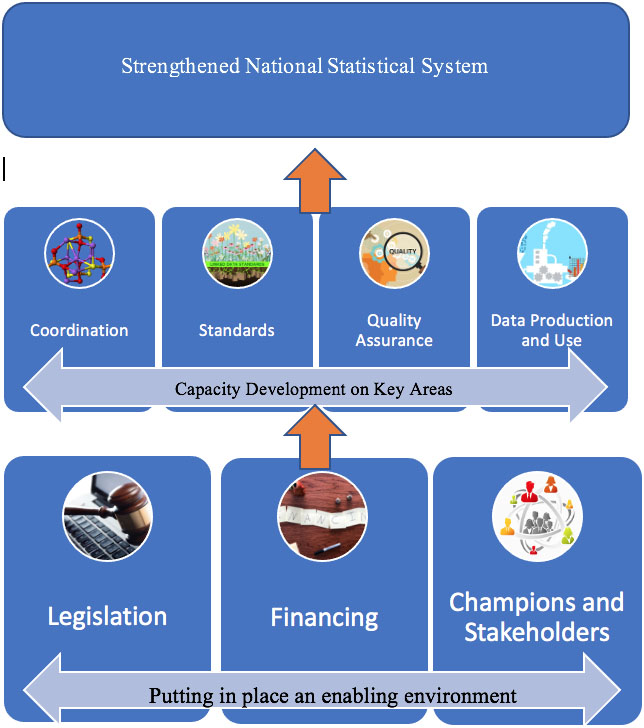
Statistical standards are a comprehensive set of statistical concepts, definitions, classifications and models, methods and procedures used to achieve the uniform treatment of statistical issues within or across processes and across time and space. The use of international standards promotes the consistency and efficiency of statistical systems and the national statistics office is expected to provide support and guidance to all data providers and producers of official statistics in the implementation of statistical standards [3]. It is expected that the system meets international standards and any divergences should be documented and explained to all stakeholders.
The development and adoption of international standards for official statistics is done under the supervision of the UN Statistical Commission(UNSC), the highest decision making body for international statistical activities, responsible for the setting of statistical standards and the development of concepts and methods, including their implementation at the national and international level [4]. This process is done using committees that the UNSC creates to develop standards. These committees are usually composed of countries, UN agencies and other partners working on the area of focus. For example, in the commission’s 53
Figure 2.
Pillars and dimensions of the statistical performance index. Source: The World Bank Statistical Performance Index Framework.
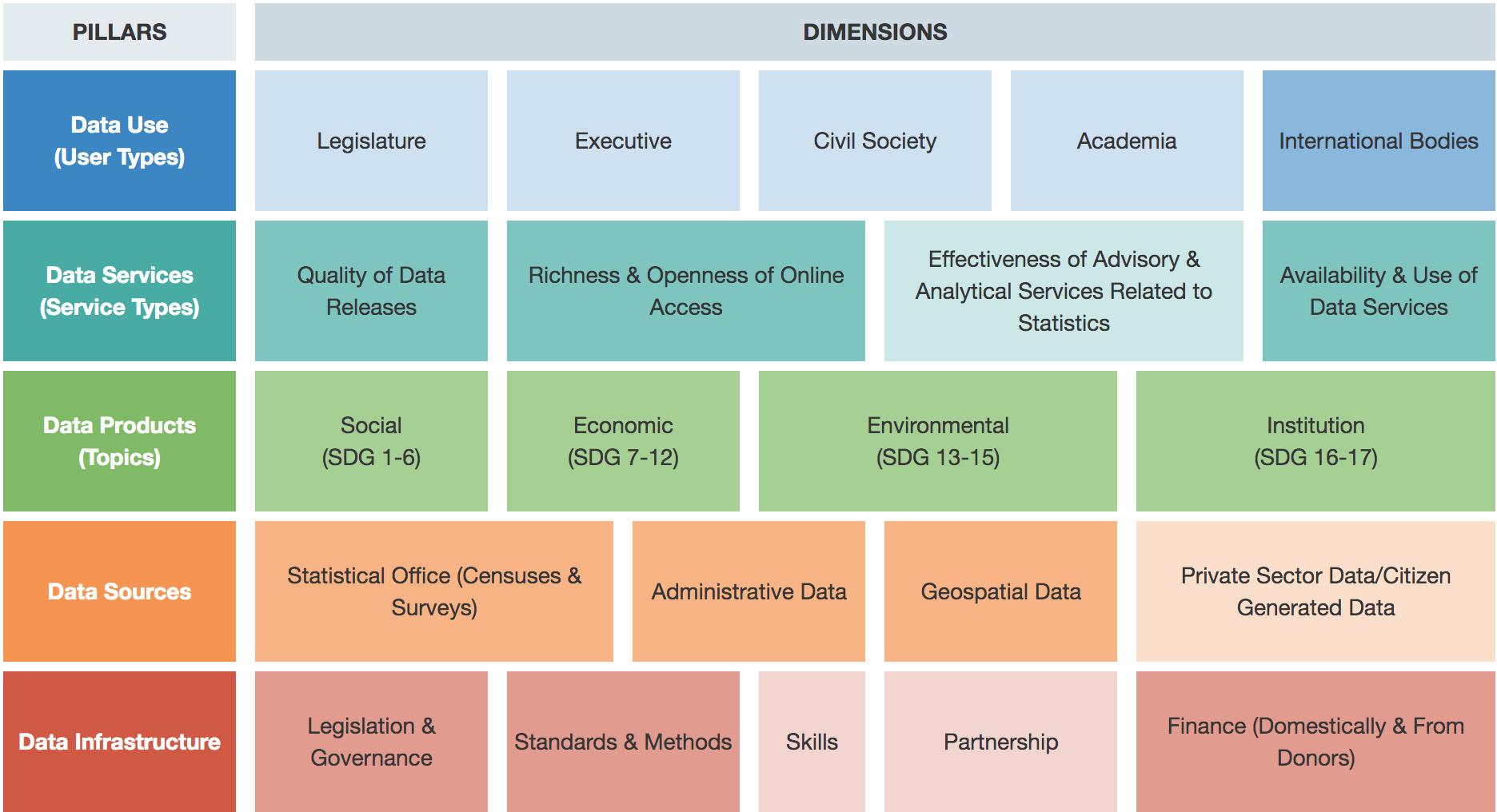
Figure 3.
Priority areas for the modernization of the national statistical system. Source: Survey on Implementation of the CT-GAP.
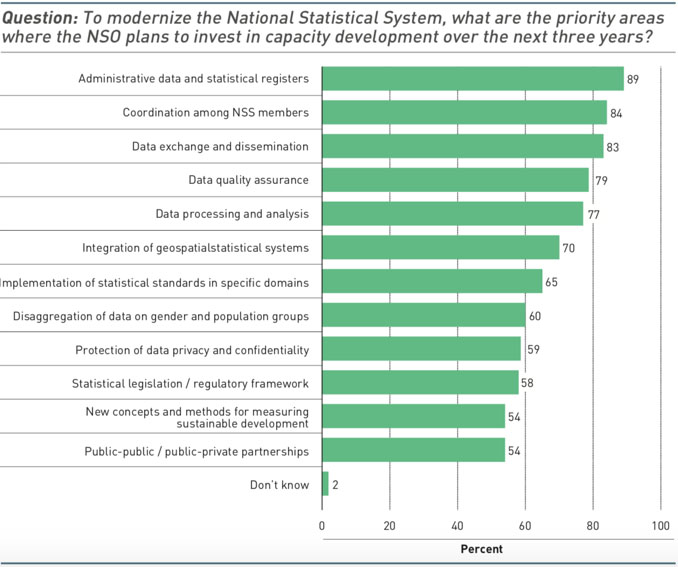
The World Bank’s Statistical Performance Index (SPI) assesses the maturity and performance of national statistical systems in five pillars: data use, data services, data products, data sources, and data infrastructure. Figure 2 [6] presents the pillars and their dimensions. It is noted that standards and methods are one dimension of the data infrastructure pillar. This dimension is based on countries’ use of internationally accepted and recommended methodologies, classifications and standards regarding data integration. These indicators help facilitate data exchange and provide the foundation for the preparation of relevant statistical indicators. The following methods and standards are considered in the development by the World Bank: the system of national accounts in use, National Accounts base year, classification of national industry, CPI base year, classification of household consumption, classification of status of employment, central government accounting status, a compilation of government finance statistics, a compilation of monetary and financial statistics, business process [7].
3.Methodology
This paper uses desk review including reports of surveys related to the study and case study to gain insights on challenges that national statistical systems face in the use of international standards. The case study is done on Mexico and the Philippines.
3.1Challenges
There is recognition of the need to transform national statistical systems so that they are able to provide statistical information to meet commitments to the 2030 Agenda made by governments of UN member states. The following strategic areas were identified by the global statistics community in a series of global and regional conferences in 2015–2016 for transformation to happen: (a) coordination and partnerships; (b) communication and advocacy; (c) integrated systems for the production of statistics; (d) innovation through the use of new technologies and data sources; and (e) capacity-building and resource mobilization [8].
In July 2017, the UN General Assembly adopted the global indicator framework for the Sustainable Development Goals and targets of the 2030 Agenda for Sustainable Development developed by the Inter-Agency and Expert Group on Sustainable Development Goal Indicators. As it did so, it explicitly requested the UN Statistical Commission to coordinate the substantive and technical work to develop international statistical standards, methods and guidelines, where necessary, to fully implement the global indicator framework to follow up and review the Sustainable Development Goals [9].
Also in 2017, the UNSC adopted the Cape Town Global Action Plan for Sustainable Development (CT-GAP) which was developed by the High-Level Group for Partnership, Coordination, Capacity Building for Statistics for the 2030 Agenda for Sustainable Development (HLG-PCCB) [10]. It aims to outline the necessary actions to generate quality and timely data on a routine basis to inform sustainable development at the requested level of disaggregation and population coverage, including for the most vulnerable and hard-to-reach groups. Among necessary actions explicitly discussed are those related to standards, a key challenge to data for the SDGs.
The strategic areas of the CT-GAP are: (1) coordination and strategic leadership on data for sustainable development; (2) innovation and modernization of national statistical systems; (3) strengthening of basic statistical activities and programs, with particular focus on addressing the monitoring needs of the 2030 Agenda; (4) dissemination and use of sustainable development data; (5) multi-stakeholder partnerships for sustainable development data; and, (6) mobilize resources and coordinate efforts for statistical capacity building. Key actions related to standards are under strategic areas (2) and (3) with the following explicit statements:
Objective 2.2: Modernize statistical standards, particularly those aimed to facilitate data integration and automation of data exchange across different stages of the statistical production process. Specific key action areas related to standards under this objective is the definition and implementation of standardized structures for the exchange and integration of data and metadata on the social, economic and environmental pillars of sustainable development and at all levels (global, regional, national and sub-national), following the SDMX and related standards. Objective 2.3: Facilitate the application of new technologies and new data sources into mainstream statistical activities with key action areas of developing specifications for interoperable, open source technologies and developing guidelines on the use of new and innovative data generated for official statistics Objective 3.5: Strengthen and expand data on all groups of population to ensure that no one is left behind with key action areas specific to social statistics such as strengthening and further development of methodology and standards for disability statistics. Objective 3.6: Strengthen and expand data on domains that are currently not well developed within the scope of official statistics with key action area of developing, standardizing and improving coverage and quality of data that today are beyond the scope of official statistics [11].
Figure 4.
Funding priorities for statistical production, by income group. Source: Survey on Implementation of the CT-GAP.
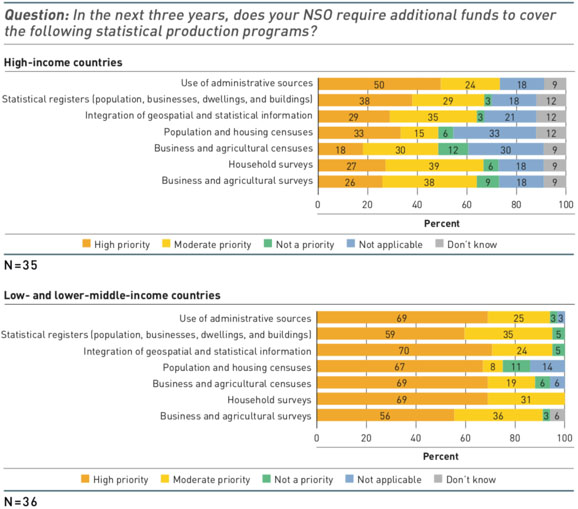
A survey of UN member states conducted by the Statistics Division of the UN Department of Economic and Social Affairs (UNSD) in 2018 to update the Fundamental Principles of Official Statistics revealed that most countries have the enabling environment needed to strengthen national statistics systems [12]. However, there are still areas that need improvement. Among challenges cited by respondents are:
1. on the use of international standards- the need to strengthen the capacity of the national statistics office to comply with international standards; lack of resources and technical knowledge, which may cause delays implementing the latest versions of international statistical classifications and standards; the need to develop and implement an inventory of international standards that is applicable to all NSS entities of the national statistical system;
2. on professional standards, scientific principles and professional ethics-lack of training and lack of knowledge by line ministries on professional and technical independence and code of ethics; inadequate human and financial resources in this area;
3. on national coordination-the need to raise awareness among line ministries on the importance of implementing international standards on data compilation and adoption of a common data quality framework; difficulties in mobilizing the resources necessary to support coordination activities through meetings and dedicated staff; lack of direct means to enforce the implementation of common standards, methods and practices across statistical units of line ministries of sub-national governments. Two surveys were able to capture the priorities and challenges that countries face on adopting international standards for official statistics.
Figure 5.
Priorities for capacity development, by income group. Source: Survey on Implementation of the CT-GAP.
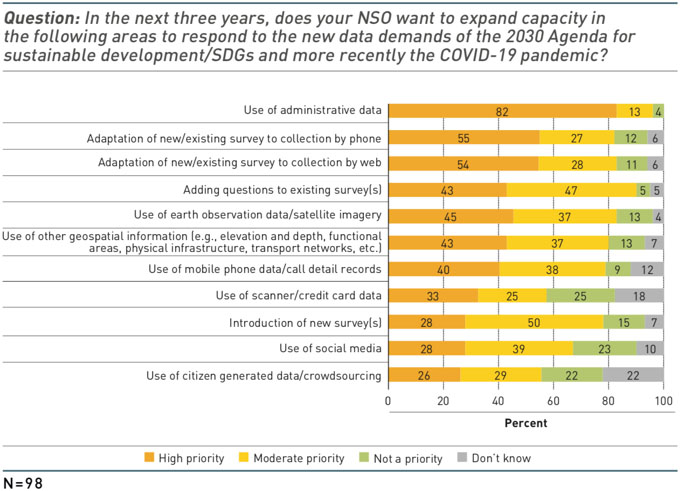
Figure 6.
Support priorities for partnerships, by income group. Source: Survey on Implementation of the CT-GAP.
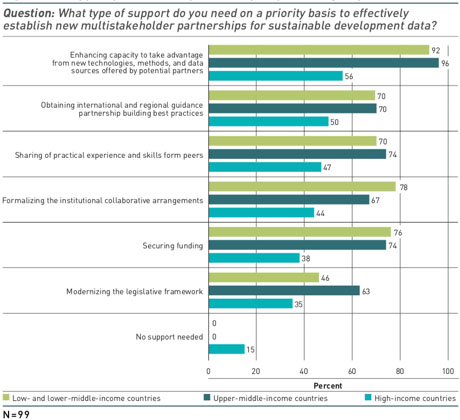
Another survey that provides insights on issues of national statistical systems in use of international standards was done by the World Bank’s Development Data Group, the Statistics Division of the UN Department of Economic and Social Affairs (UNSD), and PARIS21 in 2021 with UN member states [13]. Its objective was to find out what actions have been done for the Cape Town Global Action Plan for Sustainable Development (CT-GAP).
Figure 7.
Perception of the capacity of the national statistics office to coordinate with the entire data ecosystem, by income group. Source: Survey on Implementation of the CT-GAP.

Figure 8.
Detailed assessment of the NQAF implementation by NQAF elements. Source: Survey on the implementation of a national quality assurance framework. [3a]. Managing the statistical system: [NQAF 1] Coordinating the national statistical system; [NQAF 2] Managing relationships with data users and data providers; [NQAF 3] Managing statistical standards. [3b]. Managing the institutional environment: [NQAF 4] Assuring professional independence; [NQAF 5] Assuring impartiality and objectivity; [NQAF 6] Assuring transparency; [NQAF 7] Assuring statistical confidentiality and security; [NQAF 8] Assuring the quality commitment; [NQAF 9] Assuring adequacy of resources. [3c]. Managing statistical processes: [NQAF 10] Assuring methodological soundness; [NQAF 11] Assuring cost-effectiveness; [NQAF 12] Assuring soundness of implementation; [NQAF 13] Managing the respondent burden. [3d]. Managing statistical outputs: [NQAF 14] Assuring relevance; [NQAF 15] Assuring accuracy and reliability; [NQAF 16] Assuring timeliness and punctuality; [NQAF 17] Assuring accessibility and clarity; [NQAF 18] Assuring coherence and comparability; [NQAF 19] Managing metadata. [4a]. Measuring product and process quality: use of quality indicators, quality targets and process variables and descriptions. [4b]. Communicating about quality: quality reports. [4c]. Obtaining feedback from users. [4d]. Conducting assessments; labelling and certification. [4e]. Assuring continuous quality improvement.
![Detailed assessment of the NQAF implementation by NQAF elements. Source: Survey on the implementation of a national quality assurance framework. [3a]. Managing the statistical system: [NQAF 1] Coordinating the national statistical system; [NQAF 2] Managing relationships with data users and data providers; [NQAF 3] Managing statistical standards. [3b]. Managing the institutional environment: [NQAF 4] Assuring professional independence; [NQAF 5] Assuring impartiality and objectivity; [NQAF 6] Assuring transparency; [NQAF 7] Assuring statistical confidentiality and security; [NQAF 8] Assuring the quality commitment; [NQAF 9] Assuring adequacy of resources. [3c]. Managing statistical processes: [NQAF 10] Assuring methodological soundness; [NQAF 11] Assuring cost-effectiveness; [NQAF 12] Assuring soundness of implementation; [NQAF 13] Managing the respondent burden. [3d]. Managing statistical outputs: [NQAF 14] Assuring relevance; [NQAF 15] Assuring accuracy and reliability; [NQAF 16] Assuring timeliness and punctuality; [NQAF 17] Assuring accessibility and clarity; [NQAF 18] Assuring coherence and comparability; [NQAF 19] Managing metadata. [4a]. Measuring product and process quality: use of quality indicators, quality targets and process variables and descriptions. [4b]. Communicating about quality: quality reports. [4c]. Obtaining feedback from users. [4d]. Conducting assessments; labelling and certification. [4e]. Assuring continuous quality improvement.](https://content.iospress.com:443/media/sji/2022/38-2/sji-38-2-sji220015/sji-38-sji220015-g008.jpg)
Countries identified the implementation of statistical standards in specific domains (65%) and new concepts and methods for measuring sustainable development(54%) among the priority areas for the modernization of the national statistical system are as shown by Fig. 3 [14].
Figure 9.
Proportion of countries with available data, by Goal 2021. Source: The Sustainable Development Goals Report for 2021.
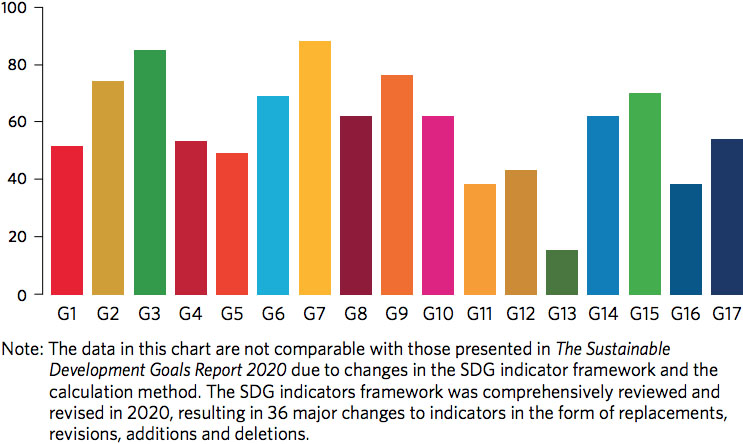
Figure 10.
Sectoral priorities for on-budget support from development cooperation providers. Source:Survey on Implementation of the CT-GAP.
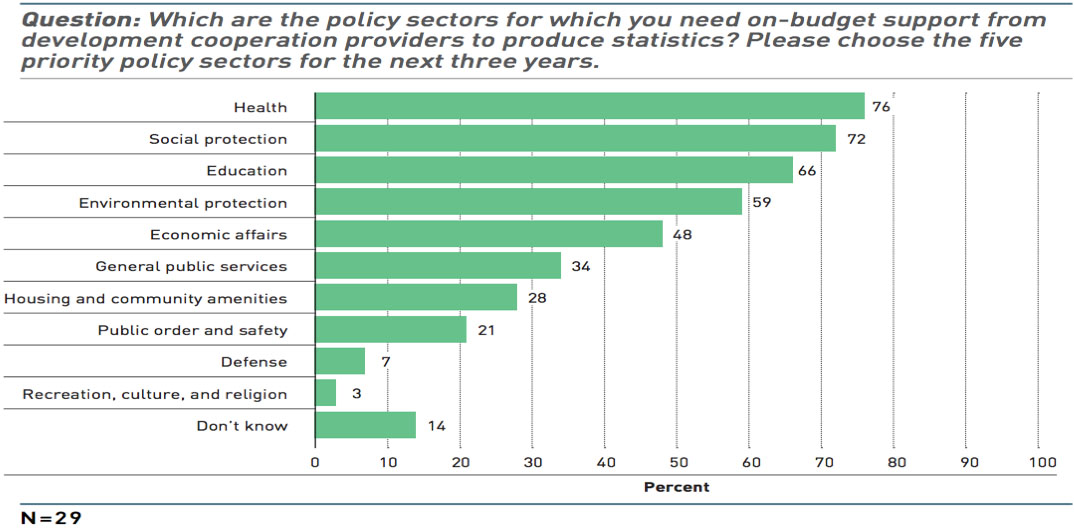
Country priorities for additional funding especially for low-income and lower-middle-income countries, in Fig. 4 [15], as well as capacity building, in Fig. 5 [16] ,indicate that countries want to take advantage of data from administrative sources and registers and big data sources such as earth observation data and mobile phone data. Countries also seek help through partnerships for enhanced capacity in the use of these new technologies, in Fig. 6 [17].
Figure 11.
Overall SPI scores, 2019.
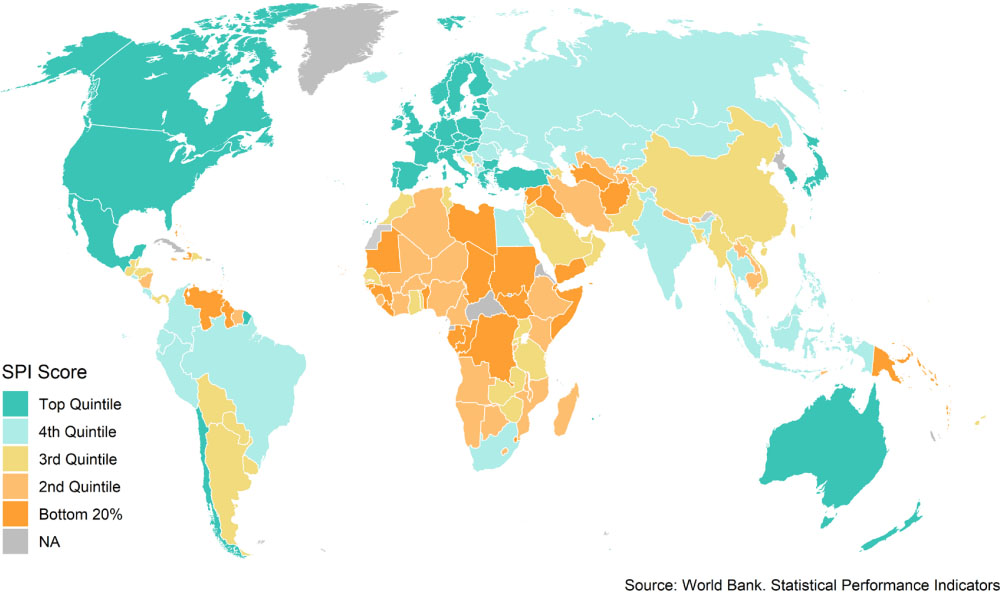
Figure 12.
Performance of Mexico in the SPI Pillars, 2019. Source: World Bank Statistical Performance Indicator.
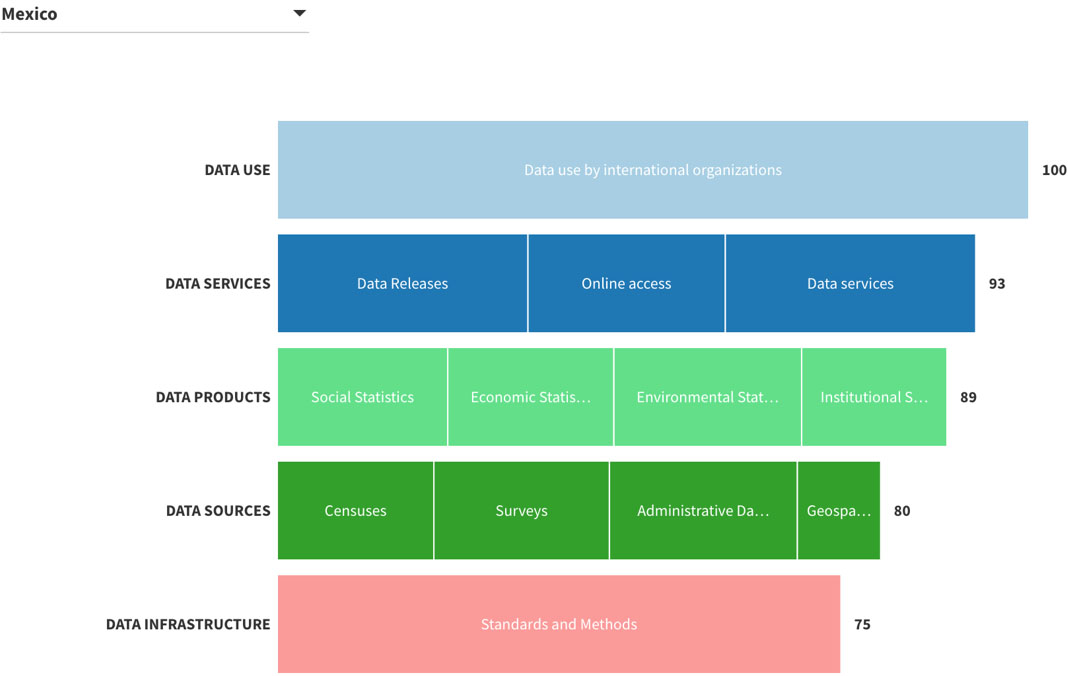
When asked about areas they will invest in for the modernization of the national statistical system, most low-income and lower-middle-income countries chose coordination among members of the system (97%) and data quality assurance (91%). This indicates that for such countries, coordination and quality assurance are still the main challenges. Most upper-middle-income selected administrative data and registers (96%) and coordination among members of the system (89%). For high-income countries, their selected priority areas were administrative data and registers (83%) and data exchange and dissemination (80%) [18]. These results on coordination as a priority is consistent with low-income to middle-income countries’ perception that the capacity of their national statistics offices is either unsatisfactory or needs improvement. It is interesting to note that Fig. 7 [18] shows that more upper-middle-income countries rated their national statistics office unsatisfactory than low-income and lower-middle-income countries.
Figure 13.
Performance of the Philippines in the SPI Pillars, 2019. Source: World Bank Statistical Performance Indicator.
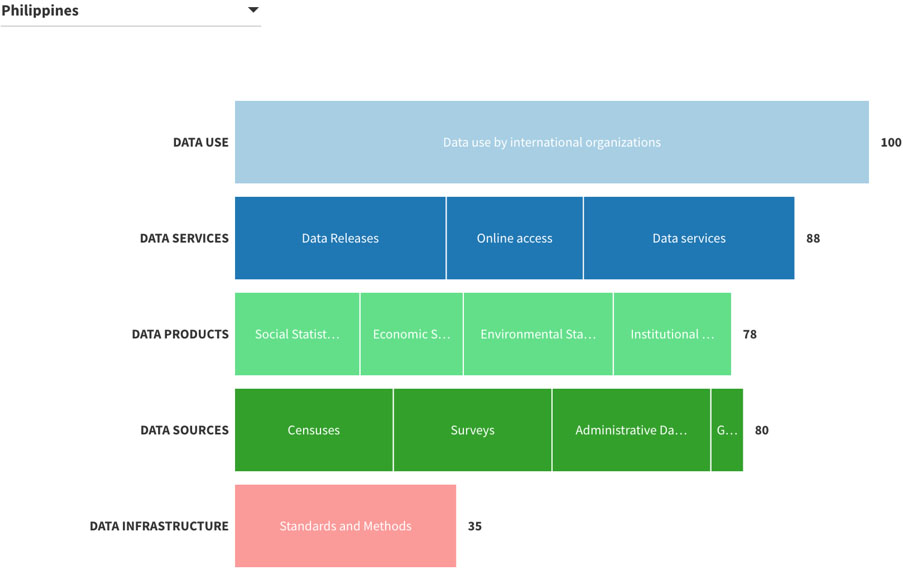
A survey on the implementation of a national quality assurance framework in countries done by the Expert Group on National Quality Assurance Frameworks (EG NQAF) and the UNSD from December 2017 to April 2018 showed that managing statistical standards( NQAF 3) is among the different areas of quality assurance that still has gaps in implementation [19]. Figure 8 [20] shows this result given the various elements of the NQAF.
Respondents in the survey recommended the following on standardization, coordination and managing relationship with stakeholders: to elaborate on standardization of methodology between data providers to ensure comparable data measures; issues related to introduction and implementation of the common metadata framework system; improving metadata structure and software, reflecting and updating the quality documentation and sharing with end-users; increasing interoperability of actors within the framework of electronic government (from the point of view of producers and consumers of official statistics) and open-data (given that there are legal regulations that sometimes hinder data sharing); issues of compliance with international standards and nomenclatures.
3.2Focus on social sector statistics
Social sector statistics is a concern. The Sustainable Development Goals Report for 2021 [21] indicates that there is considerable progress on the availability of internationally comparable data on the SDGs. The number of indicators in its global SDG database used for the report increased from 115 in 2016 to around 160 in 2019 and 211 in 2021. However, big data gaps still exist in all areas of the SDGs in terms of geographic coverage, timeliness and the level of disaggregation. Less than half of 193 countries or areas have internationally comparable data for 5 of the 17 Goals. It is noted in Fig. 9 [22], that less than 60% of countries have data for social indicators under Goal 1 (No Poverty), Goal 4 (Quality Education), and Goal 5 (Gender Equality).
Respondents of the survey for CT-GAP echoed this social sector concern when most of them identified health, social protection and education as priorities for budget support from development cooperation providers. These are presented in Fig. 10. These survey results are indicative of many challenges confronting countries in producing social sector statistics, including satisfying international standards.
4.The case of Mexico and the Philippines
The national statistical systems of Mexico, led by the Instituto Nacional de Estadistica y Geografia (INEGI) [23], and the Philippines, led by the Philippine Statistics Authority (PSA) [24], are examples of how developing countries address challenges to producing official statistics. Both INEGI and PSA are founded on legal frameworks that enable them to be the leader of their national statistical systems. INEGI was born in 1983 through Articles 33 and 34 of the Law on Statistical and Geographical Information (LIEG) with the attribute of being completely autonomous from the executive branch of government [25]. PSA was created in 2013 through the Philippine Statistics Act of 2013 [26]. Among many other accomplishments, Mexico illustrates the positive impact of the use of geospatial technologies in the conduct of censuses [27]. Both have developed the Multidimensional Poverty Index [28] to capture the multidimensional nature of poverty. The Philippines has adopted frameworks for social sector statistics that follow international standards. In 2017, for example, the following PSA Board Resolutions were adopted: Resolution 7. Approving and Adopting the Amended Operational Framework for Counting Overseas Filipinos and International Migrants; Resolution 8. Approving and Adopting the Official Concepts and Definitions on Internal and International Migration for Statistical Purposes; Resolution No. 9. Approving and Adopting the Initial List of Sustainable Development Goals for Monitoring in the Philippines; Resolution 11. Approving and Adopting the Official Methodology for the Generation of Provincial Human Development Index [29].
A look at the SPI scores and rankings of the two countries shows that Mexico is in the top quintile for SPI in 2019 ranking 13
| Country name | 2016 | 2017 | 2018 | 2019 | Rank in 2019 | Trend |
|---|---|---|---|---|---|---|
| Mexico | 80 | 89 | 88 | 88 | 13 | Increasing from 2016 to 2018/2019 |
| Philippines | 73 | 74 | 76 | 76 | 53 | Increasing from 2016 to 2018/2019 |
Figure 11 presents the SPI scores of 174 countries in 2019. It is noted that the countries in the top quintile are usually high-income countries. Figures 12 and 13 show the countries’performance in the five pillars of the SPI. Both countries achieved the maximum score of 100 in data use. Both countries had the lowest scores in data infrastructure, with the Philippines achieving a score of only 35. This is indicative of what was already presented in the previous section that there are still areas needing improvement.
5.Conclusion
National statistical systems are in a better place now to address the challenges of providing relevant information for policies and programs. However, challenges still need to be addressed by countries in various areas. Focusing on those related to standards, the following are the challenges:
• Lack of resources and technical knowledge of international standards
• Lack of inventory of international standards for entities within the national statistical system
• Lack of knowledge by line ministries on professional and technical independence and code of ethics
• Inadequate human and financial resources
• Insufficient awareness among line ministries on the importance of implementing international standards.
To address the deficiency of data, especially on social sector statistics, traditional methods and tested frameworks should be augmented by new sources of information. Partnerships need to be forged as a means of implementation.
References
[1] | UN GA, Transforming our world the 2030 Agenda for Sustainable Development, 21 October 2015, A/RES/70/1, available at: https://www.refworld.org/docid/57b6e3e44.html [accessed 3 April 2022]. |
[2] | Bersales LG. CEPA strategy guidance note on Strengthening of national statistical systems:UN DESA, February 2021, available at https://publicadministration.un.org/Portals/1/Strategy%20note%20national%20statistical%20systems%20Feb%202021.pdf. [accessed 19 March 2021]. |
[3] | UNSD and Expert Group on National Quality Assurance Frameworks, Results of a survey on the implementation of a national quality assurance framework in countries 50th session of the UN Statistical Commission, 5–8 March (2019) , p. 29, available at https://unstats.un.org/unsd/statcom/50th-session/documents/BG-Item3d-NQAF-E.pdf. [accessed 3 April 2022]. |
[4] | |
[5] | UN DESA, Report of the Committee of Experts on Big Data and Data Science for Official Statistics, 53 |
[6] | https://www.worldbank.org/en/programs/statistical-performance-indicators/Framework. |
[7] | Dang H, Pullinger J, Serajuddin U, Stacy B. Statistical Performance Indicators and Index: A New Tool to Measure Country Statistical Capacity. Policy Research Working Paper No. 9570. World Bank, Washington, DC., (2019) , available at: https://openknowledge.worldbank.org/handle/10986/35301 [accessed 3 April 2022]. |
[8] | UN ECOSOC, 2017, https://unstats.un.org/unsd/statcom/48th-session/documents/2017-5-TransformativeAgenda-E.pdf. [accessed 19 March 2021]. |
[9] | UN General Assembly, Work of the Statistical Commission pertaining to the 2030 Agenda for Sustainable Development: resolution, July 2017, A_RES_71_313-EN, July (2017) , available at https://digitallibrary.un.org/record/1291226?ln=en. [accessed 19 March 2021]. |
[10] | HLG-PCCB, 2017, https://unstats.un.org/sdgs/hlg/Cape-Town-Global-Action-Plan/. |
[11] | HLG-PCCB,2017, op. cit. |
[12] | UNSD, (2019) , https://unstats.un.org/unsd/statcom/50th-session/documents/BG-Item3b-FPOS-survey-results-E.pdf. |
[13] | World Bank, UNSD, PARIS21, Survey on the Implementation of the Cape Town Global Action Plan for Sustainable Development Data (English). Washington, D.C. : World Bank Group. http://documents.worldbank.org/curated/en/826351643712794722/Survey-on-the-Implementation-of-the-Cape-Town-Global-Action-Plan-for-Sustainable-Development-Data. |
[14] | World Bank, UNSD, PARIS21, 2021 op. cit. |
[15] | World Bank, UNSD, PARIS21, 2021 op. cit. |
[16] | World Bank, UNSD, PARIS21, 2021 op. cit. |
[17] | World Bank, UNSD, PARIS21, 2021 op. cit. |
[18] | World Bank, UNSD, PARIS21, 2021 op. cit. |
[19] | UNSD, 2019 op. cit. |
[20] | UNSD and Expert Group on National Quality Assurance Frameworks, 2019 op. cit. |
[21] | United Nations, The Sustainable Development Goals Report 2021, available at: https://unstats.un.org/sdgs/report/2021/The-Sustainable-Development-Goals-Report-2021.pdf. |
[22] | United Nations, 2021 op. cit. |
[23] | Instituto Nacional de Estadistica y Geografia website. https://www.inegi.org.mx/. |
[24] | Philippine Statistics Authority website. https://psa.gov.ph/. |
[25] | Palma M, Why INEGI? The saga of a Mexican institution in search of the truth, Instituto Nacional de Estadistica y Geografia: (2021) , pp. 80-84. |
[26] | The Philippine Statistical Act of 2013, available at https://psa.gov.ph/ssrcs-republic-act#:∼:text=10625%2C%20Otherwise%20Known%20as%20the%20Philippine%20Statistical%20Act%20of%202013&text=Art.,the%20LGUs%20and%20the%20GOCCs. |
[27] | Palma, 2021, op. cit. |
[28] | |
[29] |




